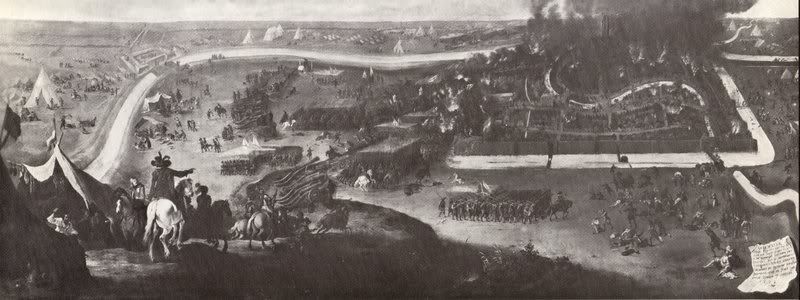
The previous parts:
Frank Anderson, Malcolm Smiley, William Reid, Hyman Ettlinger, George Birkhoff, E. H. Moore, H. A. Newton, Michel Chasles, Simeon Poisson, Joseph Lagrange, Leonhard Euler, Johan Bernoulli, Jacob Bernoulli, Gottfried Lebniz, Christiaan Huygens. Fifteen generations of my mathematical ancestors.
Yes, there was a side trip to Pierre-Simon La Place and Jean d’Alembert that ended in a dead end. And it is true that the leap from Lagrange to Euler is tenuous, what with Lagrange being pretty much self-educated in mathematics. And it is also true that Huygens was more of an inventor, a maker of clocks and telescopes…and hence an astronomer.
Christiaan received a Master of the Liberal Arts degree from the University of Leiden in 1647 and a Doctor of Canon and Civil Law from Université d’Angers in 1655. His advisors were Frans van Schooten and Jan Stampioen.
Not much is known about Stampioen, other than that he wrote a book about the geometry of the sphere, which we would today call spherical trigonometry.
 Van Schooten, on the other hand, is known as the guy who popularized Descartes work on analytical geometry. Reading the text Géométrie before its publication, he found it mostly incomprehensible…so he traveled to Paris to study the work of François Viète and Pierre de Fermat. Having done so, he felt sufficiently qualified to translate Descartes’ work into Latin, complete with commentary. Both Leibniz and Newton drew from this translation for their separate discoveries of calculus.
Van Schooten, on the other hand, is known as the guy who popularized Descartes work on analytical geometry. Reading the text Géométrie before its publication, he found it mostly incomprehensible…so he traveled to Paris to study the work of François Viète and Pierre de Fermat. Having done so, he felt sufficiently qualified to translate Descartes’ work into Latin, complete with commentary. Both Leibniz and Newton drew from this translation for their separate discoveries of calculus.
Van Schooten had two advisors at the University of Leiden: Jacobus Golius and Marin Mersenne, of Mersenne prime fame. Mersenne received his holy orders in Paris in 1613. He spent much of his time in the convent of L’Annonciade. There he hung out with “other kindred spirits” like Descartes, Étienne Pascal (Blaise’s father), Gilles de Roberval and Nicolas-Claude Fabri de Peiresc, discussing such esoteric matters as mathematics and music. And he traveled the countryside teaching philosophy and theology. But he is most famous for his correspondence.
At a time when the scientific journal had not yet come into being, Mersenne was the center of a network for exchange of information.
Mersenne’s only other mathematics student at the graduate level was Blaise Pascal.
Golius is more known for his work translating Arabic texts than as a mathematician, though some of those translations were of works about mathematics and astronomy. While the lineage ends at Mersenne, it does not end at Golius.
Golius’ only other mathematics student at the graduate level was René Descartes.
Thus van Schooten was the link between Pascal and Descartes…the third musketeer.
As happens more frequently as we move back in time, Jacobus Golius had two advisers towards earning his Ph.D. at Leiden. They were Willebrord Snellius and Thomas Erpenius (aka Thomas Van Erpe). Erpenius was what was known as an Orientalist. He earned a M.A. at Leiden but we have no further information about his education, other than that he was advised to study Oriental languages while he was studying theology by a Joseph Justus Scaliger. Some day I may follow that line. But I just saw it this morning. 🙂
 W. Snellius, on the other hand, was an astronomer and mathematician, the “Snell” of Snell’s Law of Refraction. He also determined a new method, based on triangulation, for measuring the radius of the Earth and the first new method for calculating pi since the time of the Greeks. Snellius Crater (pictured on the left) on the Moon is named after him.
W. Snellius, on the other hand, was an astronomer and mathematician, the “Snell” of Snell’s Law of Refraction. He also determined a new method, based on triangulation, for measuring the radius of the Earth and the first new method for calculating pi since the time of the Greeks. Snellius Crater (pictured on the left) on the Moon is named after him.
Willebrord had two advisers for his Master of Liberal Arts degree at Leiden in 1607. They were his father Rudolph and Ludolph van Ceulen. Van Ceulen was a refugee of the Catholic Inquisitions and the first mathematics professor at Leiden. At the time, he was better known for his fencing school. We lose the lineage here, knowing only that Van Ceulen came from Hildesheim, Germany. He spent most of his mathematical life calculating what came to be called at the time, the Ludolphine number 3.14159265358979323846264338327950288…, which was engraved on his tombstone.
 Rudolph Snel van Royen (aka Snellius) was a linguist and mathematician (mostly a logician) at both Marburg and Leiden. His fame mostly resides in the students he taught, Jacobus Arminius and Hugo Grotius, leading intellectuals in the Dutch Golden Age. Rudolph’s wife was a survivor of the Massacre of Oudewater during the Dutch revolt against the Habsburg (i.e. Spanish) Empire. [The painting above the fold is by Dirck Stoop and is entitled The Oudewater Murder. It resides in the Oudewater town hall.]
Rudolph Snel van Royen (aka Snellius) was a linguist and mathematician (mostly a logician) at both Marburg and Leiden. His fame mostly resides in the students he taught, Jacobus Arminius and Hugo Grotius, leading intellectuals in the Dutch Golden Age. Rudolph’s wife was a survivor of the Massacre of Oudewater during the Dutch revolt against the Habsburg (i.e. Spanish) Empire. [The painting above the fold is by Dirck Stoop and is entitled The Oudewater Murder. It resides in the Oudewater town hall.]
R. Snellius studied at the University of Cologne, under Valentine Naibod and at the University of Heidelberg under Immanuel Tremellius, earning a Master of Liberal Arts degree.
 An Italian Jew who converted to Christianity in 1540, Tremellius was known as a translator of the Bible from Hebrew and Syriac. He taught Hebrew at Strasbourg, at Cambridge during the wars of the Reformation, and later became a professor of the Old Testament at Heidelberg until he was expelled. His Calvinism was always getting him into hot water of one kind or another. He also translated Calvin into Hebrew. Tremellius was educated at the University of Padua, but we have no knowledge about any advisers.
An Italian Jew who converted to Christianity in 1540, Tremellius was known as a translator of the Bible from Hebrew and Syriac. He taught Hebrew at Strasbourg, at Cambridge during the wars of the Reformation, and later became a professor of the Old Testament at Heidelberg until he was expelled. His Calvinism was always getting him into hot water of one kind or another. He also translated Calvin into Hebrew. Tremellius was educated at the University of Padua, but we have no knowledge about any advisers.
Valentine Naibod (aka Valentin Naboth) was a German mathemtician, astronomer, astrophysicist, and astrologer. His family was also originally Jewish. He attended the Martin Luther University of Halle-Wittenberg in 1544 and transferred to Erfurt in 1550. He taught mathematics in Cologne at a time when mathematics was not part of the general curriculum…not until he came along, that is.
Great story:
In March 1564 Naboth resigned from his position at the University of Cologne.[7] He traveled to Italy, eventually settling in Padua. There Naboth came to a bad end. He was living in Padua, Italy, when he deduced from his own horoscope that he was about to enter a period of personal danger, so he stockpiled an adequate supply of food and drink, closed his blinds, and locked his doors and windows, intending to stay in hiding until the period of danger had passed. Unfortunately, some thiefs, seeing the house closed and the blinds drawn, decided that the resident was absent. They therefore broke into what they thought was an empty house, and, finding Naboth there, murdered him to conceal their identities. Thus he did not escape the fate predicted by his own astrological calculations: “Ducunt volentem fata, nolentem trahunt”.
That line of Latin translates thusly: Fate leads the willing; and drags the unwilling.
 Naibod’s Table of Times is still used by astrologers today.
Naibod’s Table of Times is still used by astrologers today.
Naibod’s adviser at Wittenberg was Erasmus Rheinhold, who is “an” Erasmus, not “the” Erasmus. Educated at Wittenberg, he became dean and the rector. In 1536 he was appointed professor of higher mathematics. But he was basically an astronomer. His major creation was the set of Prutenic (or Prussian) Tables, published in 1551, the first set of astronomical tables based on the work of Copernicus in 1543. Erasmus’ tables established Copernicus as being a mathematician on the level of Ptolemy. These tables were used by Clavius as the basis for the Gregorian calendar reform.
It is interesting, however, that Rheinhold rejected Copernicus’ heliocentric cosmology on theological grounds.
To be continued…

12 comments
Skip to comment form
Author
the other day for a way to share your mp3’s, so I assembled something you can use…
This one is set up to play an mp3 that I uploaded to googlepages.com.
If you copy and paste this code:
<embed src=”http://i165.photobucket.com/albums/u65/vradul/flvplayer.swf” flashvars=”&file=http://vradul.googlepages.com/ArethaFranklin-NaturalWoman.mp3&height=21&width=300″ width=”300″ height=”21″></embed>
it will produce this:
If you upload an mp3 to any free file hosting service, and then replace the bolded link in this code with a link to your mp3 then it will play that one. (the .swf file is the player itself)
by doing this:
<embed src=”http://i165.photobucket.com/albums/u65/vradul/flvplayer.swf”
flashvars=”showicons=true
&file=http://vradul.googlepages.com/ArethaFranklin-NaturalWoman.mp3
&image=http://i216.photobucket.com/albums/cc143/rserven/edge.jpg
&height=250&width=300″ width=”300″ height=”250“></embed>